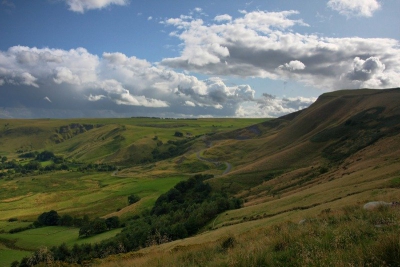National parks of the United Kingdom (Welsh: parciau cenedlaethol; Scottish Gaelic: pircean niseanta) are areas of relatively undeveloped and scenic landscape across the country. Despite their name, they are quite different from national parks in many other countries, which are usually owned and managed by governments as protected community resources, and which do not usually include permanent human communities. In the United Kingdom, an area designated as a national park may include substantial settlements and human land uses that are often integral parts of the landscape. Land within national parks remains largely in private ownership. These parks are therefore not truly "national parks" according to the internationally accepted standard of the IUCN but they are areas of outstanding landscape where planning controls are a little more restrictive than elsewhere.
Within the United Kingdom there are fourteen national parks of which ten are in England, three in Wales and two in Scotland. There is one further area in England with "equivalent status".
An estimated 110 million people visit the national parks of England and Wales each year. Recreation and tourism bring visitors and funds into the parks, to sustain their conservation efforts, and support the local population through jobs and businesses. However, these visitors also bring problems, such as erosion and traffic congestion, and conflicts over the use of the parks' resources. Access to cultivated land is restricted to public rights of way and permissive paths. (Under the Countryside and Rights of Way Act 2000 there is a right of access for walkers to most but not all uncultivated areas in England and Wales.)
The Peak District is an upland area in England at the southern end of the Pennines. Mostly in Derbyshire, it extends into Cheshire, Greater Manchester, Staffordshire, West Yorkshire and South Yorkshire. It includes the Dark Peak, where moorland is found and the geology gritstone, and the White Peak, a limestone area with valleys and gorges. The Dark Peak forms an arc on the north, east and west sides; the White Peak covers central and southern tracts. The historic Peak District extends beyond the National Park, which excludes major towns, quarries and industrial areas. It became the first of the national parks of England and Wales in 1951. Nearby Manchester, Stoke-on-Trent, Derby and Sheffield send millions of visitors – some 20 million live within an hour's ride. Inhabited from the Mesolithic era, it shows evidence of the Neolithic, Bronze and Iron Ages. Settled by the Romans and Anglo-Saxons, it remained largely agricultural; mining arose in the Middle Ages. Richard Arkwright built cotton mills in the Industrial Revolution. As mining declined, quarrying grew. Tourism came with the railways, spurred by the landscape, spa towns and Castleton's show caves.

1951Apr, 17
The Peak District becomes the United Kingdom's first National Park.
Choose Another Date
Events on 1951
- 11Apr
President Truman's relief of General Douglas MacArthur
Korean War: President Harry Truman relieves General of the Army Douglas MacArthur of overall command in Korea. - 22Apr
Battle of Kapyong
Korean War: The Chinese People's Volunteer Army begin assaulting positions defended by the Royal Australian Regiment and the Princess Patricia's Canadian Light Infantry at the Battle of Kapyong. - 25Apr
Battle of Kapyong
Korean War: Assaulting Chinese forces are forced to withdraw after heavy fighting with UN forces, primarily made up of Australian and Canadian troops, at the Battle of Kapyong. - 3May
Harry Truman
The United States Senate Committee on Armed Services and United States Senate Committee on Foreign Relations begin their closed door hearings into the dismissal of General Douglas MacArthur by U.S. President Harry Truman. - 15Oct
Combined oral contraceptive pill
Mexican chemist Luis E. Miramontes conducts the very last step of the first synthesis of norethisterone, the progestin that would later be used in one of the first three oral contraceptives.

 English
English  español
español  français
français  português
português  русский
русский  العربية
العربية  简体中文
简体中文 